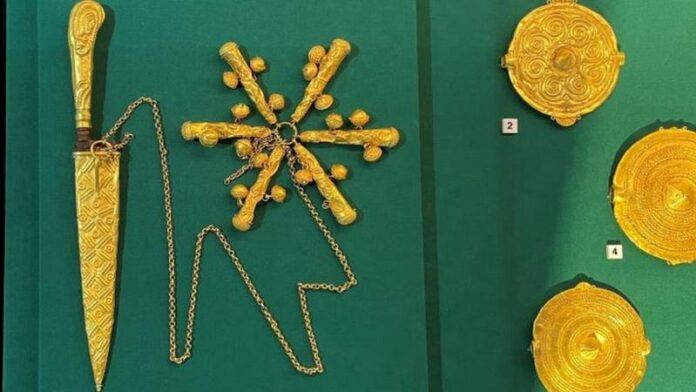After 150 years of separation, looted artefacts from the Asante kingdom have finally found their way back to Ghana, much to the jubilation of its people. The long-awaited homecoming of these treasures has been marked by a momentous display at the Manhyia Palace Museum in Kumasi, the capital of the Asante region.
Ghanaians from all walks of life gathered at the museum to welcome the return of 32 significant items, revered as the “crown jewels” of the Asante kingdom. Among the crowd, palpable excitement filled the air as drums reverberated with a sense of pride and cultural resurgence.
“This is a day for Asante. A day for the Black African continent. The spirit we share is back,” proclaimed Asante King Otumfuo Osei Tutu II, encapsulating the profound significance of the artefacts’ repatriation.
While the items are currently on loan for three years, the possibility of extending the loan offers hope for a more enduring reunion. The agreement, brokered between two British museums – the Victoria & Albert Museum (V&A) and the British Museum – and the Asante king, underscores the complexities of reclaiming cultural heritage.
Henry Amankwaatia, a retired police commissioner and proud Asante, expressed the collective sentiment, stating, “Our dignity is restored.” The return of these artefacts symbolizes a tangible step towards healing the wounds of history and reclaiming cultural identity.
The artefacts, including the sword of state, gold peace pipe, and gold badges worn by royal officials, hold profound historical and spiritual significance for the Asante people. Some were looted during the Anglo-Ashanti wars of the 19th Century, while others, like the gold harp (Sankuo), were acquired through diplomatic exchanges.
Also, read; Britain Sends First Voluntary Asylum Seeker to Rwanda, Sun Newspaper Reports
Dr. Tristam Hunt, director of the Victoria and Albert Museum, acknowledged the painful history surrounding the acquisition of these objects, tainted by the scars of imperial conflict and colonialism. He emphasized the power of cultural exchange and reconciliation, heralding the artefacts’ return as a testament to shared heritage.
Among the returned items, the sword of state, or “mpompomsuo sword,” holds particular reverence. Used in swearing the oath of office to the kingdom by paramount chiefs and the king himself, it embodies the sovereignty and tradition of the Asante people.
Royal historian Osei-Bonsu Safo-Kantanka poignantly remarked that the artefacts’ departure had taken away “a portion of our heart, our feeling, our whole being.” Their return signifies not only a restoration of cultural treasures but also a reclamation of national pride and identity.
While the loan agreement offers a temporary solution, aspirations for permanent restitution persist among many Ghanaians. However, navigating British legal restrictions presents a formidable challenge, prompting creative approaches to facilitate the return of looted artefacts.
As Ghana celebrates this historic reunion, it joins a global chorus calling for justice and recognition of the rightful ownership of cultural heritage. The repatriation of Asante gold artefacts serves as a poignant reminder of the enduring legacy of colonialism and the resilience of African nations in reclaiming their history.

